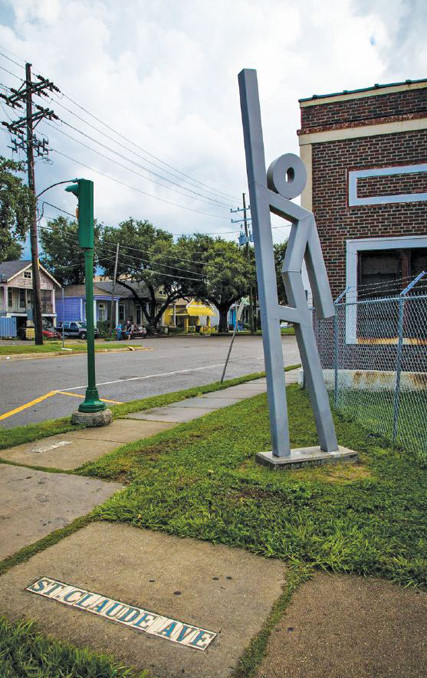 An EvacuSpot sculpture marks an emergency pick-up point in New Orleans. (Photo by James Shaw, courtesy of Evacuteer.org)
An EvacuSpot sculpture marks an emergency pick-up point in New Orleans. (Photo by James Shaw, courtesy of Evacuteer.org)
In the wake of a natural disaster like Hurricane Sandy or a terrorist incident like the Boston Marathon bombing, news reports invariably feature brave citizens who pull together to face adversity. Heartwarming though they are, such tales don’t tell the full story of what it takes for a city to recover from a major disruption.
Resilience on a citywide scale requires “complex systems to be able to quickly return to normal and to build back,” says Neill Coleman, vice president of global communication at the Rockefeller Foundation. “You need more than a sense of ‘We’re going to overcome this.’”
What helps some cities bounce back while others struggle for years after disaster strikes? That’s one question that the Rockefeller Foundation aims to answer over the course of a three-year initiative called the 100 Resilient Cities Centennial Challenge. The foundation will invest $100 million to sponsor resilience-enhancing efforts by selected cities. (It will name the first round of award cities in December 2013.) Each city, for example, will receive support to create a new position: chief resilience officer (CRO).
Resilient cities, Coleman says, are able to look forward “rather than trying to prevent the last disaster.” Early lessons about urban resilience—drawn from fields as diverse as disaster preparedness, public health, and social psychology—point to the importance of factors such as flexibility and resourcefulness.
Even in cities with a detailed disaster-preparedness plan, “there will be failure,” says Craig Applegath, a Toronto-based architect and a pioneer in this emerging discipline. A truly resilient city, he suggests, will have a ready response to this crucial question: What kinds of operational strategies are in place to help a city prepare for that failure and recover quickly?
Bouncing back isn’t always possible. Resilience, in many cases, “is actually about adapting to a new situation—a new normal,” says Douglas Ahlers, director of the Harvard Kennedy School Broadmoor Project, a redevelopment effort that focuses on a New Orleans neighborhood that was devastated by Hurricane Katrina.
Ahlers suggests thinking of resilience in terms of “layers of protection or strength.” Like slices in a block of Swiss cheese, “each layer has holes in it,” he explains. “If the disturbance to the system hits a solid part of the resilience layer, it stops. But if it hits a hole, it advances to the next slice.” If the prevention layer fails, for example, then the crisis mitigation layer and the emergency response layer become critical. “Resilience is about closing the holes,” Ahlers says.
The CRO role will require a generalist who can navigate all the layers and mobilize all the players. “Whoever gets the job will need to be, first, a diplomat,” says Applegath. In addition, he notes, the job involves the “responsibility of tying together many different silos of expertise”—from engineering to economics.
Each city’s CRO will serve as point person for resilience planning and as a coordinator of cross-sector activity. “We know this person will need to be a networker, a connector,” Coleman says. “We also expect them to play the role of an evangelist for resilience thinking.”
The good news is that city resilience appears to be a learnable skill. That was the message sent by Judith Rodin, president of the Rockefeller Foundation, at a forum in June that her organization cohosted with PopTech and the Brooklyn Academy of Music. She associated resilience with “what we build in those moments between catastrophe and the next big disruption.” Examples range from San Francisco’s adoption of tougher building codes (to ensure that new structures can withstand future earthquakes) to an initiative in New Orleans to identify and highlight “EvacuSpots”—places where people can meet to exit the city safely in the event of an oncoming storm.
Cities chosen for the Resilient Cities project will gain access to a network of people with whom they can share strategies, along with help in figuring out how to pay for improvements. “Many city leaders realize that they should be making an investment now to save millions [of dollars] in the future,” Coleman says. “But it’s not easy to find those up-front funds. We hope to connect cities with innovative finance solutions.”
Support SSIR’s coverage of cross-sector solutions to global challenges.
Help us further the reach of innovative ideas. Donate today.
Read more stories by Suzie Boss.

